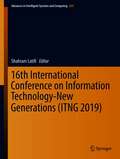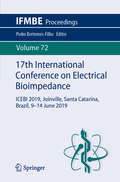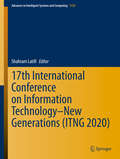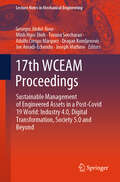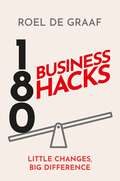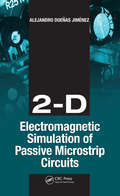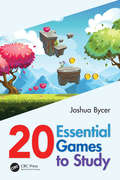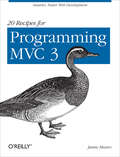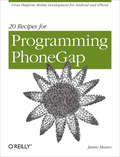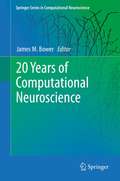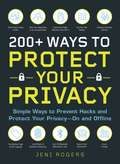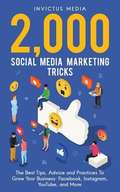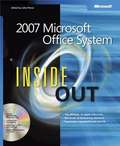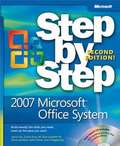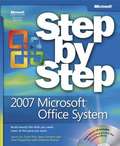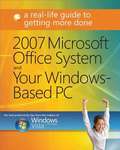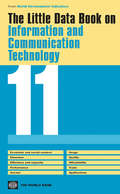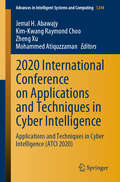- Table View
- List View
16th International Conference on Information Technology-New Generations (Advances in Intelligent Systems and Computing #800)
by Shahram LatifiThis 16th International Conference on Information Technology - New Generations (ITNG), continues an annual event focusing on state of the art technologies pertaining to digital information and communications. The applications of advanced information technology to such domains as astronomy, biology, education, geosciences, security and health care are among topics of relevance to ITNG. Visionary ideas, theoretical and experimental results, as well as prototypes, designs, and tools that help the information readily flow to the user are of special interest. Machine Learning, Robotics, High Performance Computing, and Innovative Methods of Computing are examples of related topics. The conference features keynote speakers, the best student award, poster award, service award, a technical open panel, and workshops/exhibits from industry, government and academia.
17th International Conference on Electrical Bioimpedance: ICEBI 2019, Joinville, Santa Catarina, Brazil, 9-14 June 2019 (IFMBE Proceedings #72)
by Pedro Bertemes-FilhoThis book gathers the proceedings of the 17th International Conference on Electrical Bioimpedance (ICEBI 2019), held on June 9-14, in Joinville, Santa Catarina, Brazil. The chapters cover the latest knowledge and developments concerning: sensors and instrumentation to measure bioimpendance, bioimpedance imaging techniques, theory and modeling and bioimpendance, as well as cutting-edge clinical applications of bioimpendance. All in all, this book provides graduate students and researchers with an extensive and timely snapshot of current research and challenges in the field of electrical bioimpendance, and a source of inspiration for future research and cross-disciplinary collaborations.
17th International Conference on Information Technology–New Generations (Advances in Intelligent Systems and Computing #1134)
by Shahram LatifiThis volume presents the 17th International Conference on Information Technology—New Generations (ITNG), and chronicles an annual event on state of the art technologies for digital information and communications. The application of advanced information technology to such domains as astronomy, biology, education, geosciences, security, and healthcare are among the themes explored by the ITNG proceedings. Visionary ideas, theoretical and experimental results, as well as prototypes, designs, and tools that help information flow to end users are of special interest. Specific topics include Machine Learning, Robotics, High Performance Computing, and Innovative Methods of Computing. The conference features keynote speakers; a best student contribution award, poster award, and service award; a technical open panel, and workshops/exhibits from industry, government, and academia.
17th WCEAM Proceedings: Sustainable Management of Engineered Assets in a Post-Covid 19 World: Industry 4.0, Digital Transformation, Society 5.0 and Beyond (Lecture Notes in Mechanical Engineering)
by Joseph Mathew Adolfo Crespo Márquez Joe Amadi-Echendu Dragan Komljenovic Turuna Seecharan Georges Abdul-Nour Minh Ngoc Dinh17th WCEAM Proceedings provides a record of some of the intellectual discussions (including keynote addresses, research paper presentations, panel debates and practical workshops) that took place among the attendees and participants of the 17th World Congress on Engineering Asset Management (WCEAM), held from 18 - 20 October 2024 at the Sheraton Saigon Hotel and Towers, Ho Chi Minh City, Vietnam. The events were organized by the International Society for Engineering Asset Management (ISEAM) and hosted by RMIT University Vietnam LLC (RMIT VN), Ho Chi Ming City. The content of the book includes topics listed below under a general theme of Sustainable Management of Engineered Assets in a Post-Covid World: Industry 4.0, Digital Transformation, Society 5.0 and beyond Sustainable asset investment, acquisition, operations, maintenance, and retirement strategies Production-service transformation and product-service systems Sustainable asset acquisition, operations, maintenance, and retirement processes Modeling and simulation of acquisition, operations, maintenance, and retirement processes Reliability and resilience engineering Applications of the Fourth Industrial Revolution (4IR) technologies in EAM, e.g., Digital Twins Cybersecurity issues in asset management Asset condition, risk, resilience, and vulnerability assessments Asset management and decision support systems Applications of international and logical guidelines and standards in EAM Human dimensions and asset management performance Case studies of asset management in various industries and sectors This proceedings is an excellent resource for asset management practitioners, researchers and academics, as well as undergraduate and postgraduate students.
180 Business Hacks: Little Changes, Big Difference
by Roel de Graaf180 OF THE SHARPEST AND STICKIEST WAYS TO GET BETTER RESULTS AT WORK"Flip the org chart and put the customer on top." "Write the press release before you start development." "Give someone busy more work to do." In 180 Business Hacks, you'll find these and 177 other surprising, sharp and inspiring ways to get better results at work. These cheat codes will help you succeed by shifting the way you think about business problems. Conventional thinking gets you conventional results but often the stickiest ideas are small. And like tiny cracks, they eventually turn into in something bigger. The hacks are organized into 9 themed chapters (Innovation, Strategy, Structure, Management, Analysis, Portfolio, Change, Impact and Effectiveness) so you can find them quickly, but for best results just flip through and open at random. You'll always find something unexpected to add to your daily routine.
180 Business Hacks: Little Changes, Big Difference
by Roel de Graaf180 OF THE SHARPEST AND STICKIEST WAYS TO GET BETTER RESULTS AT WORK"Flip the org chart and put the customer on top." "Write the press release before you start development." "Give someone busy more work to do." In 180 Business Hacks, you'll find these and 177 other surprising, sharp and inspiring ways to get better results at work. These cheat codes will help you succeed by shifting the way you think about business problems. Conventional thinking gets you conventional results but often the stickiest ideas are small. And like tiny cracks, they eventually turn into in something bigger. The hacks are organized into 9 themed chapters (Innovation, Strategy, Structure, Management, Analysis, Portfolio, Change, Impact and Effectiveness) so you can find them quickly, but for best results just flip through and open at random. You'll always find something unexpected to add to your daily routine.
2 em 1: Guia Pokémon 20 dicas e truques que você deve ler + Pokémon Go - Poupando a bateria
by Fernanda Ranieri Silva Game GuidezLIVRO DUPLO: Por um tempo limitado pegue ambos os livros por um preço de pechincha: Dobre sua vida da bateria & acelere seu progresso em Pokémon com este .. LIVRO DUPLO: Por um tempo limitado pegue ambos os livros por um preço de pechincha: Há tantas coisas valiosas, nós sabemos que você vai adorar: Seja o melhor treinador Pokémon que você pode ser! Em nosso guia mergulhamos diretamente nas dicas e truques que o ajudarão a se tornar um mestre no menor tempo possível. Nós o guiamos de mãos dadas com algumas das dicas mais cobiçadas e truques descobertos no jogo até agora. Se você quiser acelerar a sua diversão, este livro é para você! Alguns dos tópicos que abordamos: Começando Encontrando mais Pokémon Aumentando de nível de forma mais rápida e mais eficiente Como encontrar Pokémon em grupo Como economizar sua bateria com estratégias avançadas Itens Dicas e truques de Realidade Aumentada Dicas especiais do Pokéstop Segredos e sugestões Estão incluídos muito mais dicas, truques e segredos. Se você não quiser enrolação e apenas chegar diretamente ao ponto do que deve fazer, este é o livro para você! Leia a sua cópia hoje e torne-se o mestre que você é! Eu posso ensinar-lhe como DOBRAR sua vida da bateria ou mais! Em nosso guia, mergulhamos diretamente nas dicas e truques que o ajudarão a dominar a vida da bateria no menor tempo possível. Nós o guiamos de mãos dadas com algumas das dicas mais cobiçadas e truques descobertos em como salvar a sua preciosa vida da bateria. Se você quiser fazer sua diversão durar um longo tempo, este é o livro para você! Alguns dos tópicos que abordamos: Drenagem de som Aplicativos em segundo plano Como dobrar instantaneamente a sua bateria! Diminu
2-D Electromagnetic Simulation of Passive Microstrip Circuits
by Alejandro D. JimenezGlobal Demand for Streamlined Design and Computation The explosion of wireless communications has generated a tidal wave of interest and development in computational techniques for electromagnetic simulation as well as the design and analysis of RF and microwave circuits. Learn About Emerging Disciplines, State-of-the-Art Methods2-D Electromagnetic Simulation of Passive Microstrip Circuits describes this simple procedure in order to provide basic knowledge and practical insight into quotidian problems of microstrip passive circuits applied to microwave systems and digital technologies. The text dissects the latest emerging disciplines and methods of microwave circuit analysis, carefully balancing theory and state-of-the-art experimental concepts to elucidate the process of analyzing high-speed circuits. The author covers the newer techniques – such as the study of signal integrity within circuits, and the use of field map interpretations – employed in powerful electromagnetic simulation analysis methods. But why and how does the intrinsic two-dimensional simulation model used here reduce numerical error? Step-by-Step Simulation Provides Insight and UnderstandingThe author presents the FDTD electromagnetic simulation method, used to reproduce different microstrip test circuits, as well as an explanation of the complementary electrostatic method of moments (MoM). Each reproduces different microstrip test circuits that are physically constructed and then studied, using a natural methodological progression to facilitate understanding. This approach gives readers a solid comprehension and insight into the theory and practical applications of the microstrip scenario, with emphasis on high-speed interconnection elements.
20 Essential Games to Study
by Joshua BycerThe purpose of this book is to look over the past 35 years of games to discuss titles whose design deserves to be studied by anyone with an interest in game design. While there are plenty of books that focus on the technical side of Game Development, there are few that study the nature of game design itself. Featuring a mix of console and PC offerings, I purposely left off some of the easy choices (Mario, Starcraft, Call of Duty, Overwatch) to focus on games that stood out thanks to their designs. Key Features An informative breakdown focusing on the design and gameplay of successful games Written to be useful for students or designers starting out in game development Books focused specifically on design are rare Perfect for students and professionals alike, or can be read for the nostalgia and history
20 Recipes for Programming MVC 3: Faster, Smarter Web Development
by Jamie MunroThere's no need to reinvent the wheel every time you run into a problem with ASP.NET's Model-View-Controller (MVC) framework. This concise cookbook provides recipes to help you solve tasks many web developers encounter every day. Each recipe includes the C# code you need, along with a complete working example of how to implement the solution. Learn practical techniques for applying user authentication, providing faster page reloads, validating user data, filtering search results, and many other issues related to MVC3 development.These recipes help you:Restrict access to views with password protectionAllow users to upload and save a file to your websiteImplement AJAX to allow users to see updated content quicklyValidate form input to ensure the data you capture is what you expectCreate thumbnails to preview images rather than view them full-sizeGive your web application the ability to change languagesUse CAPTCHA to prevent automated programs from completing formsMake URLs more user- and search-engine-friendly with the MapRoute function
20 Recipes for Programming PhoneGap: Cross-Platform Mobile Development for Android and iPhone
by Jamie MunroGain hands-on experience with the amazing PhoneGap library, using the practical recipes in this handy guide. With these solutions, you can enable your mobile web apps to interact with device-specific features such as the accelerometer, GPS, camera, and address book. Learn how to use your knowledge of HTML, CSS, and JavaScript to build full mobile apps for iOS, Android, and several other platforms without rewriting apps in the native platform language. Each recipe includes sample code you can use in your project right away, as well as a discussion of why the solution works.Add functionality that’s available only on a certain device or platformRetrieve the device’s current GPS location and place a marker on a mapCreate and save a new contact or edit an existing contact in the address bookTake pictures with the camera or select one of the user’s existing photosUpload a file from the local device to an external serverAllow the device to record audio or video through your appEnable your application to save files locally
20 Years of Computational Neuroscience (Springer Series in Computational Neuroscience #9)
by James M BowerWhen funding agencies and policy organizations consider the role of modeling and simulation in modern biology, the question is often posed, what has been accomplished ? This book will be organized around a symposium on the 20 year history of the CNS meetings, to be held as part of CNS 2010 in San Antonio Texas in July 2010. The book, like the symposium is intended to summarize progress made in Computational Neuroscience over the last 20 years while also considering current challenges in the field. As described in the table of contents, the chapter's authors have been selected to provide wide coverage of the applications of computational techniques to a broad range of questions and model systems in neuroscience. The proposed book will include several features that establish the history of the field. For each article, its author will select an article originally appearing in a CNS conference proceedings from 15 - 20 years ago. These short (less than 6 page) articles will provide illustrations of the state of the field 20 years ago. The new articles will describe what has been learned about the subject in the following 20 years, and pose specific challenges for the next 20 years. The second historical mechanism will be the reproduction of the first 12 years of posters from the CNS meeting. These posters in and of themselves have become famous in the field (they hang in the halls of the NIH in Bethesda Maryland) and were constructed as allegories for the state and development of computational neuroscience. The posters were designed by the book's editor, who will, for the first time, provide a written description of each poster.
200+ Ways to Protect Your Privacy: Simple Ways to Prevent Hacks and Protect Your Privacy--On and Offline
by Jeni RogersDiscover simple strategies for protecting your personal and confidential information on and offline with this essential and easy-to-understand guide. We all know that the internet can serve as a hotbed for identity theft. But it isn’t the only place where your privacy can be breached. In fact, there are lots of ways you can protect your privacy (or diminish it) that have little or nothing to do with access to the internet. Your home, your photos, your trash can, your kids, your favorite restaurant or store—and even you have the ability to unknowingly reveal your private information to everyone from thieves to busybodies. But you don’t need to hire a specialist to keep your information safe—you can do it yourself with these 200+ easy-to-implement tactics, some of which include: —Shredding hard copies of bills — Turning off Bluetooth when not in use — Using a firewall — Hiding spare keys in an unusual place Keeping your information secure lies in your hands—make sure you’re not putting yourself at risk in your daily habits with this essential guide.
2000 Social Media Marketing Tricks: The Best Tips, Advice And Practices To Grow Your Business: Facebook, Instagram, Youtube, And More
by Invictus MediaIf you're looking to grow your business bigger and faster than you ever imagined possible, using a step-by-step guide on how to utilize social media marketing....THIS BOOK IS FOR YOU! <p><p> "2000 SOCIAL MEDIA MARKETING TRICKS" is a title of more than just tips and tricks you can apply to social media platforms - it is a DONE WITH YOU guide to ensure your growing success on the current hottest platforms out there - Facebook, Instagram, Youtube, and others! <p> Don't waste another day wondering when is the perfect time to join in on the social media frenzy. Start taking your business to the next level and purchase your copy today.
2007 Microsoft® Office System Inside Out
by John PierceWritten for experienced Office users, this guide explains what features and interfaces have changed in the 2007 versions of Word, Excel, PowerPoint, Outlook, and Access. The 2007 edition adds chapters on Groove, Visual Basic for Applications, and XML formats. The CD-ROM contains sample files, bonus chapters, links to third- party tools, and the Microsoft computer dictionary, 5th ed. Annotation ©2008 Book News, Inc. , Portland, OR (booknews. com)
2007 Microsoft® Office System Inside Out
by Microsoft CorporationDive into the essential features in Microsoft Office Access® 2007, Excel® 2007, Outlook® 2007, PowerPoint® 2007, and Word 2007. This supremely organized reference is packed with hundreds of timesaving solutions, troubleshooting tips, and workarounds. It's all muscle and no fluff. Discover how the experts tackle what's new in your favorite Microsoft Office programs--and challenge yourself to new levels of mastery! Expertly manage your inbox, contacts, and business information Master sophisticated document-layout and formatting techniques Build spreadsheets to help you perform complex calculations and data analysis Design databases, build data-collection forms, and manipulate data Learn advanced techniques for creating charts and reports Create dynamic slides using themes, custom slide layouts, and special effects Explore Office Groove® 2007 and Windows® SharePoint® Services for powerful collaboration Configure security and privacy settings to help thwart worms, viruses, and malware Write macros using Microsoft Visual Basic® for Applications and work with Office Open XML CD includes: Fully searchable eBook--plus bonus chapters! 30+ sample files--spreadsheets, databases, code, and XML Resources for customizing, configuring, and troubleshooting programs Links to demos, webcasts, training courses, and blogs Visual references for finding commands in the Microsoft Office Fluent user interface Online resources for InfoPath® 2007, OneNote® 2007, Project 2007, and Visio® 2007 Windows Vista® Product Guide eReference and other eBooks A Note Regarding the CD or DVD The print version of this book ships with a CD or DVD. For those customers purchasing one of the digital formats in which this book is available, we are pleased to offer the CD/DVD content as a free download via OReilly Medias Digital Distribution services. To download this content, please visit OReillys web site, search for the title of this book to find its catalog page, and click on the link below the cover image (Examples, Companion Content, or Practice Files). Note that while we provide as much of the media content as we are able via free download, we are sometimes limited by licensing restrictions. Please direct any questions or concerns to booktech@oreilly.com.
2007 Microsoft® Office System Plain & Simple
by Marianne Moon Gerald Joyce<div xmlns="http://www.w3.org/1999/xhtml"><p>Get the fast facts that make learning the 2007 Microsoft Office system plain and simple! This no-nonsense guide uses easy numbered steps and concise, straightforward language that show the most expedient ways to learn a skill or solve a problem.</p></div>
2007 Microsoft® Office System Plain & Simple
by Jerry Joyce Marianne MoonHere's WHAT You'll Learn Easily navigate the new user interface Create documents, Web pages, and other publications Organize your e-mail, calendar, and tasks Build spreadsheets to manage and analyze data Build a simple database Design and deliver a slide show presentation Here's HOW You'll Learn It Jump in wherever you need answers Easy-to-follow STEPS and SCREENSHOTS show exactly what to do Handy TIPS teach new techniques and shortcuts Quick TRY THIS! exercises help you apply what you learn right away
2007 Microsoft® Office System Step by Step
by Joan Lambert Joyce Cox Steve Lambert John Pierce M. Dow Lambert III Curtis D. FryeThe smart way to learn Microsoft Office--one step at a time! The second edition of this popular book features new and expanded content. In addition to covering familiar Microsoft Office applications such as Microsoft Office AccessTM 2007, Excel® 2007, Outlook® 2007, PowerPoint® 2007, and Word 2007--you now also get coverage of Microsoft Office Publisher 2007, SharePoint® Server 2007, Groove® 2007, OneNote® 2007, and InfoPath® 2007. Work at your own pace through the easy numbered steps, practice files on CD, helpful hints, and troubleshooting help to learn the fundamentals of working with the 2007 Microsoft Office system, including how to navigate the new user interface. Learn how to create professional-quality documents, powerful spreadsheets, and compelling slide presentations. And discover how to get your Web site up and running, take notes electronically, and manage your e-mail communications and workday. The companion CD includes skill-building practice files, eBooks, and more. With STEP BY STEP, you can take just the lessons you need or work from cover to cover. Either way, you drive the instruction--building and practicing the skills you need, just when you need them! A Note Regarding the CD or DVD The print version of this book ships with a CD or DVD. For those customers purchasing one of the digital formats in which this book is available, we are pleased to offer the CD/DVD content as a free download via OReilly Medias Digital Distribution services. To download this content, please visit OReillys web site, search for the title of this book to find its catalog page, and click on the link below the cover image (Examples, Companion Content, or Practice Files). Note that while we provide as much of the media content as we are able via free download, we are sometimes limited by licensing restrictions. Please direct any questions or concerns to booktech@oreilly.com.
2007 Microsoft® Office System Step by Step
by Curtis Frye Joan Preppernau Joyce Cox Steve LambertWork at your own pace through the easy numbered steps, practice files on CD, helpful hints, and troubleshooting help to learn the fundamentals of working with the 2007 Microsoft Office system, including how to navigate the new user interface. You will learn how to create professional-quality documents, powerful spreadsheets, and compelling slide presentations. You will also discover how to get your Web site up and running, how to take notes electronically, and how to manage your e-mail communications and workday. The companion CD includes skill-building practice files, eBooks, and more!
2007 Microsoft® Office System Step by Step
by Curtis Frye Katherine Murray Joan Preppernau Joyce Cox Steve LambertQuickly teach yourself how to use Microsoft Office Access 2007, Excel 2007, Outlook 2007, PowerPoint 2007, and Word 2007. With Step By Step, you set the pace--building and practicing the skills you need, just when you need them! Take control of your day--organize your e-mail, calendar, and meetings Learn the essentials for creating effective documents Build spreadsheets and perform calculations on your data Design database applications to help manage information Produce and deliver compelling slide show presentations Organize and format text to craft professional-quality documents Your all-in-one learning experience includes: Files for building skills and practicing the book's lessons Fully searchable eBook Bonus quick reference to the Ribbon, the new Microsoft Office interface Windows Vista Product Guide eBook--plus other resources on CD A Note Regarding the CD or DVD The print version of this book ships with a CD or DVD. For those customers purchasing one of the digital formats in which this book is available, we are pleased to offer the CD/DVD content as a free download via O'Reilly Media's Digital Distribution services. To download this content, please visit O'Reilly's web site, search for the title of this book to find its catalog page, and click on the link below the cover image (Examples, Companion Content, or Practice Files). Note that while we provide as much of the media content as we are able via free download, we are sometimes limited by licensing restrictions. Please direct any questions or concerns to booktech@oreilly.com.
2007 Microsoft® Office System and Your Windows®-Based PC: A Real-Life Guide to Getting More Done
by Future Publishing<div xmlns="http://www.w3.org/1999/xhtml"><p>From the makers of Windows Vista\xae: The Official Magazine\u2014the ultimate visual guide to the fun, practical, and creative things you can do right now with Microsoft Office!</p></div>
2007 Microsoft® Office System and Your Windows®-Based PC: A Real-Life Guide to Getting More Done
by Windows Vista MagazineGet organized, get creative, and get more done--with the ultimate real-life guide to Microsoft Office and Windows Vista. Written by the editors and product testers at Windows Vista: The Official Magazine, this book focuses on practical, everyday scenarios and fast, reliable results. All in full color! 1. Get Started: From the five-minute guide to personalizing your desktop--to getting familiar with Office programs and features--you'll find smart and simple tips to get up and running quickly. 2. Explore: Now that you know your way around, dig in--and take control of your day. Build brilliant documents. Create stunning slides and charts. Fix your own connectivity problems. Brand yourself. Blog. Sync and share files. Go wireless. Go mobile. 3. Do More: Get inspired--and go further--with imaginative projects for you, your family, and friends.
2011 The Little Data Book On Information And Communication Technology
by World BankThis Little Data Book presents tables for over 213 economies showing the most recent national data on key indicators of information and communications technology (ICT), including access, quality, affordability, efficiency,sustainability, and applications.
2020 International Conference on Applications and Techniques in Cyber Intelligence: Applications and Techniques in Cyber Intelligence (ATCI 2020) (Advances in Intelligent Systems and Computing #1244)
by Jemal H. Abawajy Kim-Kwang Raymond Choo Mohammed Atiquzzaman Zheng XuThis book presents innovative ideas, cutting-edge findings, and novel techniques, methods, and applications in a broad range of cybersecurity and cyberthreat intelligence areas. As our society becomes smarter, there is a corresponding need to secure our cyberfuture. The book describes approaches and findings that are of interest to business professionals and governments seeking to secure our data and underpin infrastructures, as well as to individual users.
